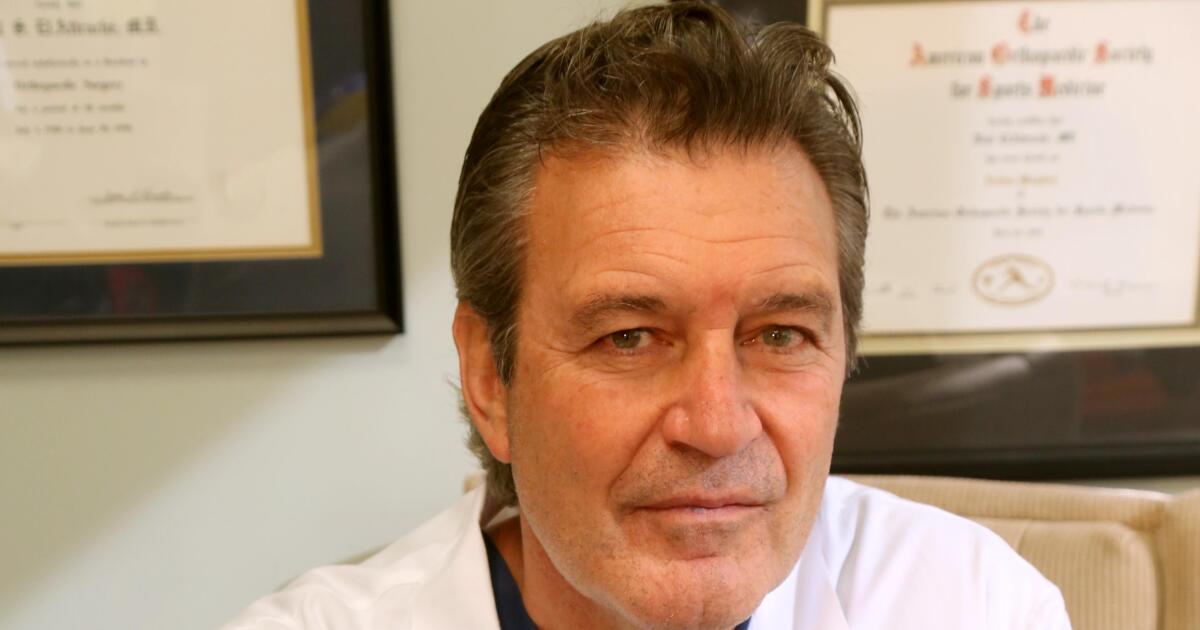Dodgers star Shohei Ohtani is throwing so well in the wake of his second Tommy John elbow surgery that his rehabilitation team is beginning to tap the brakes.
“We’re trying to keep his velocity down because it needs to be more of a gradual thing,” Dodgers team physician Neal ElAttrache told the Los Angeles Times on Thursday, saying he would prefer the two-way phenom’s pitching velocity stay under 90 mph for the moment but that it has crept up to 93.
ElAttrache performed both Tommy John operations on Ohtani, the first in 2018 and the second last September.
Ohtani is the Dodgers’ designated hitter and earlier this month became the first player in Major League history with at least 50 home runs and 50 stolen bases in the same season.
“Almost every time you look at what he’s doing, he proves that he’s one of one,” ElAttrache said of the $700-million offseason acquisition.
Just as Dodgers president of baseball operations Andrew Friedman did with reporters this week, ElAttrache threw cold water on the fantasy of Ohtani returning to the pitching mound for this postseason.
“It’s not really a good idea for anyone coming back from elbow or shoulder surgery to make their return to competition in the postseason,” the surgeon said. “There are no minor-league games to get rehab starts for return to competition this time of year, so their first competition would be in postseason high-stress conditions.
“Not a good idea for the player or the team.”
Whereas Ohtani is the charter member of the 50/50 club, ElAttrache could become the first surgeon in the four-for-four club.
He repaired the elbow of Ohtani, on track for his third Most Valuable Player award, along with probable Cy Young winners Tarik Skubal of the Detroit Tigers and Chris Sale of the Atlanta Braves. ElAttrache also fixed the shoulder of New York Yankees outfielder Aaron Judge, the likely American League MVP.
Wednesday marked the 50th anniversary of the first Tommy John surgery, performed on a Dodgers pitcher of the same name. It was pioneered by legendary surgeon Frank Jobe, who, along with Bob Kerlan, formed the Kerlan-Jobe Orthopedic Clinic, where ElAttrache has spent his entire career.
“ACL reconstructions are more frequent in sports,” ElAttrache said. “But in terms of saving the careers of baseball players, there’s nothing like the Tommy John.”
ElAttrache began learning the operation in 1990 as a Kerlan-Jobe fellow. By his estimate, he has performed 50 to 75 Tommy John surgeries every year for three decades.
The procedure involves replacing a damaged ulnar collateral ligament in a player’s throwing elbow by grafting a tendon from the wrist of his non-throwing arm. Those wrist tendons, while durable, are not necessary to everyday functions, and in fact about 20% of people don’t even have them.
A second Tommy John surgery, as i n the case of Ohtani, is known as a Tommy John revision.
“Just because you’ve had one doesn’t make you bulletproof,” ElAttrache said. “If you can rip up the ligament God gave you, you can rip up the one we put in.”
Not surprisingly, the rate of return to peak performance drops from the first Tommy John to the second. But ElAttrache said there are no indications Ohtani will be anything but superb when he returns to pitching.
As for ElAttrache, he threw out the ceremonial first pitch at Dodger Stadium on the anniversary of the first Tommy John surgery. The two sons of the late Jobe threw pitches of their own.
Catching the doctor’s throw was Dodgers pitcher Walker Buehler.
“I’ve done two Tommy Johns on him,” ElAttrache said. “He said, ‘You know I wouldn’t have let anyone else catch this pitch.’ And I said, ‘I was counting on this, Walker. I would have been standing there waiting for you to come out if you didn’t.’ ”

